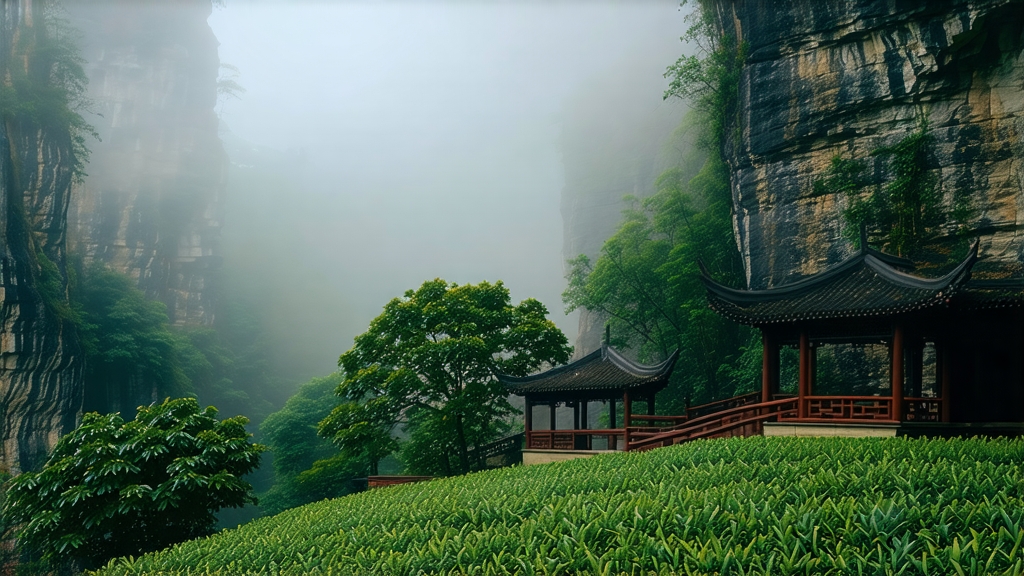
If green tea is China’s springtime whisper and pu-erh its autumnal soliloquy, then Da Hong Pao—Big Red Robe—must be the cliff-hung aria that has echoed through the Wuyi Mountains for more than three centuries. Revered as the “King of Rock Teas,” this oolong is less a beverage than a cultural biography written in leaf, fire, and stone. To understand it is to trace the veins of Chinese tea history itself.
Origin Myth and Imperial Robes
Legend places the birth of Da Hong Pao during the Ming dynasty. A passing scholar, crippled by fever, was revived by tea offered by monks of the Wuyi Tianxin Temple. Upon attaining the highest imperial exam score, the scholar returned in crimson robes to drape the mother bushes in gratitude—hence the name. Whether apocryphal or not, the tale cemented the tea’s status; by the Qing court it was tribute tea so precious that finished leaves were escorted by armed guard from Fujian to Beijing. Only 20–30 g reached the Forbidden City each year, an amount the Kangxi Emperor deemed “worth more than jade.”
Terroir: Cliffs, Mist, and Mineral Memory
The Wuyi Shan UNESCO World Heritage site is a sandstone and tuff gorge system where 36 peaks and 99 valleys create a natural amphitheater of humidity and temperature swing. Daytime heat forces the tea roots to draw minerals from weathered volcanic rock; night mist slows oxidation, condensing amino acids into floral precursors. Locals call this yanyun—“rock rhyme”—a tactile finish that feels like licking wet slate after a lightning storm. True “Zheng Yan” (core cliff) gardens occupy fewer than 60 hectares on the north-facing ledges of Nine-Dragon Gorge, where the mother trees—six ancient bushes now 360 years old—still cling to fissures. Since 2006 these venerable plants have been officially retired from plucking; every kilo on the market today descends from three vegetative lines: Qidan, Beidou, and Queshe, propagated by soft-wood cuttings in the 1980s to preserve genetic identity.
Craft: The Dance of Green and Red
Da Hong Pao is the most oxidized of the Wuyi rock oolongs (40–60 %), yet it is never allowed to cross into black-tea territory. The choreography begins at dawn when two leaves and a bud are snapped with a resonant “pop” that signals ideal turgor pressure. Wilting occurs on bamboo trays set inside the cave-like doorways of cliff cottages; cool mountain air reduces moisture to 65 % within three hours. The real magic happens during the yaoqing—“wavering green”—stage: trays are rhythmically shaken every 20 minutes for 6–8 hours, bruising the leaf margins while keeping the veins intact. This partial rupture invites polyphenol oxidase to create the amber rim that gives rock tea its “green heart with red skirt.” Fixation at 220 °C in a cast-iron wok halts oxidation, followed by a 30-minute rolling session that twists leaves into the distinctive “dragonfly head, frog leg” strip. The tea is then baked, not once but three times, over a lychee-wood charcoal pit whose temperature curve resembles a cardiogram: 120 °C for two hours, 90 °C overnight, 80 °C for four days. Between each firing the leaves rest in earthen jars to re-absorb ambient moisture, a process known as tuihuo—“returning fire.” The result is a leaf that looks charcoal-black yet exudes orchid and honey when crushed in the palm.
Grades and Market Navigation
Contemporary Da Hong Pao exists on a spectrum of authenticity. At the apex are “mother-tree clones” harvested from Qidan or Beidou stock grown inside the Zheng Yan micro-zone; production is under 500 kg annually and retails above US $3,000 per 500 g. Next comes “commercial blends,” where master tasters marry 30 % Zheng Yan leaf with 70 % from the outer “Ban Yan” belt, achieving the rock rhyme at accessible prices. Finally, “flavor-profile Da Hong Pao” uses Fujianese shrub cultivars (often Fuding Da Bai) scented with oak smoke and molasses; while legally sold as Dahongpao, it lacks mineral depth.